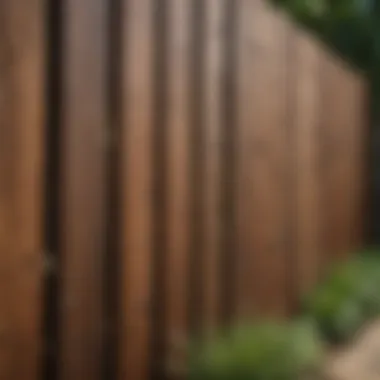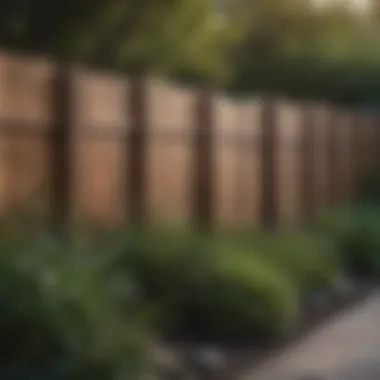Navigating Costs of Backyard Fence Installation


Intro
Installing a backyard fence involves numerous considerations that can significantly affect the overall cost. Homeowners often find themselves entangled in various elements that contribute to this investment. Understanding these factors is crucial for anyone looking to enhance their property with a fence. This article aims to provide a detailed overview of the essential elements influencing the cost of fence installation.
By examining materials, labor, permits, and more, we prepare you with the insights needed to make an informed decision. Additionally, it’s important to consider design aspects that reflect your personal style and preferences. In this guide, you will find key information to help navigate the financial aspects of installing a backyard fence.
Design Inspiration
Designing a fence is not only about functionality; it's also about aesthetics. Homeowners should take time to explore different design ideas that complement their property. Here are some trending styles and color palettes to consider.
Trending Styles
- Modern Minimalist: Simple lines and open designs define this style. Using materials like metal or wood, a minimalist fence can provide security without overwhelming the landscape.
- Rustic Farmhouse: Characterized by natural wooden materials, this style blends seamlessly into a garden or rural setting, creating a warm ambiance.
- Traditional Picket: A classic style that never goes out of fashion. Typically white, this design creates a charming and inviting atmosphere.
- Contemporary Vertical Slats: This sleek design offers a modern look while maintaining some privacy. Vertical slats can also enhance a yard's length with clever placement.
Color Palettes
Choosing the right colors for your fence can enhance both its appearance and your overall landscape. Consider these options:
- Natural Wood Stain: Retains the wood's natural beauty while offering protection. Ideal for rustic-themed gardens.
- Neutral Tones: Shades like gray or beige blend well with various architectural styles. They can complement both traditional and contemporary settings.
- Bold Colors: Vibrant tones such as deep blue or forest green make a statement and can add personality to your outdoor space.
Practical Tips
Understanding practical aspects of your fence installation can aid in effective budgeting and planning. Here are some tips to consider:
Maintenance & Care
Regular maintenance is essential to prolong the lifespan of your fence. Here are some care tips:
- Inspect for damage annually. Look for any cracks, rot, or rust.
- Clean your fence regularly. Remove dirt and debris that can accumulate over time.
- Apply protective finishes or stains as needed to prevent weather damage.
Budgeting & Planning
Planning your budget is crucial. Consider the following points:
- Material Costs: Research various materials like wood, vinyl, or metal. Each comes with its own price range.
- Labor Expenses: Hiring professionals can increase costs. Get quotes from multiple contractors to avoid overspending.
- Permits: Some areas require permits for fence installation. Check local regulations to ensure compliance and avoid fines.
"Every detail, from style to material, plays a role in the overall cost and aesthetic of your fence. Take time to research each factor before making decisions."
Understanding Fence Installation Costs
Understanding the costs involved in fence installation is essential for any homeowner looking to enhance their property. A fence not only serves as a boundary but also adds aesthetic value and increases privacy. Understanding these costs enables informed decisions, ultimately ensuring that the project stays within budget and meets expectations.
When delving into costs, multiple elements come into play. Initially, material selection plays a critical role. Components such as wood, vinyl, and wrought iron each carry distinct price tags that can greatly affect the overall expenditure. Furthermore, labor costs can vary based on whether one opts for a professional service or chooses a DIY approach.
Equally important is the understanding of local regulations and permitting costs. These often overlooked aspects can lead to unexpected expenses if not duly considered. By being aware of these elements, you can better navigate the complexities of fence installation, potentially avoiding pitfalls that can inflate prices unexpectedly. A comprehensive cost analysis can lead to not only a more satisfying project outcome but also greater enjoyment and peace of mind.
Defining Key Cost Components
Several key components substantially influence the total cost of installing a backyard fence. These include:
- Materials: The choice of material is perhaps the most significant determinant of price. Wood may offer charm and warmth but requires regular maintenance. Vinyl is durable, while chain link might be the most affordable option. Wrought iron, on the other hand, adds elegance but carries a higher cost.
- Labor: Hiring professionals might seem straightforward, but labor costs can vary by region and experience level. DIY projects may cut costs but require skill and time.
- Permitting: Local regulations may require permits that come with additional fees. Understanding these requirements can help avoid costly fines later on.
- Accessories: Additional features like gates or security enhancements can also escalate costs. Consider how each of these components adds to your total budget.
Importance of Budgeting for Fence Installation


Budgeting is pivotal when installing a fence. A clear budget helps in setting realistic expectations while preventing overspending. Homeowners should assess their finances and determine what they are willing to invest. This results in more directed material choices and prevents the heartbreak of choosing a style that is financially unfeasible.
Additionally, establishing a budget takes into account potential hidden costs that may arise. For example, preparation of the land may require leveling or clearing, which can add unexpected expenses.
Ultimately, the importance of a well-defined budget cannot be overstated. It aligns your vision with reality, ensuring that the fence effectively complements your property without financial strain.
Factors Influencing Cost
Understanding the factors influencing the cost of a backyard fence is crucial for homeowners looking to make an informed investment. Each element plays a significant role in determining both initial expenses and ongoing maintenance costs. Evaluating these factors helps in developing a more precise budget and ensuring that the fence meets specific needs without overspending.
Material Choices
Material choices are a primary decision point when planning a fence. Each type of material offers unique attributes that affect cost, durability, and aesthetic appeal. It's essential to weigh these characteristics carefully.
Wood
Wood is a traditional choice for backyard fences, known for its natural beauty and versatility. The key characteristic of wood is its ability to blend with the environment. It can be stained or painted to achieve different looks, making it popular among homeowners who value customization. A unique feature of wood is its ease of installation, particularly for DIY enthusiasts. However, it does require regular maintenance, such as staining or sealing, which can add to long-term expenses.
Vinyl
Vinyl fencing has gained popularity in recent years due to its low maintenance needs. The key characteristic of vinyl is its durability; it resists weathering, fading, and pests better than wood. It is a beneficial choice for those who want a long-lasting option with minimal upkeep. However, the unique feature of vinyl is its initial cost, which can be higher than wood. Homeowners must consider whether the long-term savings offset the upfront investment.
Chain Link
Chain link fencing is an economical option that offers strength and security. The key characteristic of chain link is its transparency, allowing visibility while providing a barrier. This makes it a favored choice for pet owners who want to keep animals contained without obstructing views. One advantage is its relatively low installation cost, but a disadvantage is its aesthetic appeal. Many find it less visually pleasing compared to other options.
Wrought Iron
Wrought iron fencing is synonymous with elegance and durability. The key characteristic of wrought iron is its strength, making it a secure option. It is also customizable with various designs. A unique feature of wrought iron is its longevity; when properly maintained, it can last for decades. Nonetheless, its high initial cost can be a barrier for some homeowners, and it may require more upkeep than other materials.
Composite
Composite fencing is a blend of recycled materials, combining durability with eco-friendliness. The key characteristic of composite is its resistance to fading, warping, and insects. This material is ideal for homeowners seeking a low-maintenance solution. The unique feature of composite is its aesthetic appeal; it often mimics the look of wood without the drawbacks. However, its cost can be relatively high, so it is essential to consider budget constraints.
Size and Height of the Fence
The size and height of the fence directly correlate with installation costs. Taller fences or larger areas will naturally incur higher material and labor expenses. Homeowners need to determine the appropriate height based on privacy needs or local regulations.
Terrain Considerations
Terrain can substantially affect the cost of fence installation.
Flat vs. Sloped
A flat terrain generally allows for a simpler fence installation process. Conversely, sloped areas may require additional grading or curved fencing, which can increase costs. The unique challenge of slope is the need for specialized skills to ensure the fence remains stable
Landscaping Features
Landscaping features such as trees, rocks, and flower beds can complicate the installation process. Any necessary alterations to these features may add to the overall cost. It is sometimes beneficial to consult with professionals to navigate these changes efficiently.
Accessibility and Location
Accessibility and location also play a crucial role in determining costs.


Urban vs. Rural Areas
In urban areas, fencing may be subject to stricter regulations and higher labor costs due to limited space. On the other hand, rural areas can offer more flexibility but may lead to higher transportation costs for materials. Understanding the local context is key.
Proximity to Services
Proximity to services affects material delivery and labor scheduling. Areas with easy access to suppliers may incur lower costs due to reduced transportation expenses, whereas remote locations can drive up the overall expense.
Labor Costs and Considerations
Understanding labor costs is critical when planning for a backyard fence installation. These costs can significantly impact the overall budget. Deciding whether to tackle the project yourself or hire professionals can change the financial dynamics. Making a thoughtful choice here has implications for both expenses and time. Homeowners must weigh the pros and cons carefully to ensure they are making the right decision for their specific situation.
DIY vs. Hiring Professionals
The allure of saving money often leads many homeowners to consider the do-it-yourself (DIY) option for fence installation. Engaging in a DIY project has its advantages. It allows for greater control over design and personal touches. However, there are considerable downsides. Skills and experience can vary widely among individuals. A lack of expertise may lead to mistakes that could cost more to fix later on. Tool availability is another factor. Without the right tools, a DIY project can become more laborious and stressful.
On the other hand, hiring professionals typically assures a certain level of quality and expertise. Skilled contractors can efficiently handle the installation, ensuring it meets local standards. This is particularly important in areas with strict building codes. However, this convenience comes at a price. Professional fees can vary based on reputation, experience, and local market rates. In many cases, hiring a contractor can add significant costs, but it can save time and stress in the long run.
Ultimately, the decision between DIY and hiring professionals should reflect not only financial considerations but also time availability and level of comfort with home improvement tasks.
Estimating Labor Expenses
Calculating labor expenses for fence installation can be challenging. Many factors influence these costs, some of which may not be immediately apparent. Factors to consider include:
- Type of Fence: Different materials require various installation techniques. For example, a reinforced concrete fence may have higher labor costs than a simple wooden one.
- Scope of Work: The total length of the fence and its height significantly affect labor hours. A taller and longer fence typically means more complicated installation.
- Local Rates: Labor rates can widely vary based on geographic location. Urban areas may have higher wages than rural settings due to demand for skilled labor.
- Complexity: Fencing on sloped terrain or dealing with obstacles like trees can complicate installations. This can increase labor time and costs due to the need for special equipment and techniques.
Understanding the nuances of labor costs is essential. A well-planned estimate prevents surprises.
Homeowners should take time to gather quotes from several contractors if choosing to hire help. This allows for comparison and can assist in selecting the best pricing without sacrificing quality. If available, consider consulting online resources or community forums to find average costs in your area. Such insights provide additional context when estimating labor expenses.
Permitting and Regulations
Understanding the regulations and permits involved in installing a backyard fence is essential for ensuring a smooth and compliant installation process. Many homeowners overlook this crucial aspect, which can lead to unexpected issues and expenses if not addressed. Knowing the local building codes and the requirements for permits helps avoid delays and potential fines.
Understanding Local Building Codes
Local building codes dictate what types of fences can be constructed, the height limits, and material specifications. Each jurisdiction may have different laws, and these codes often take into account factors like property boundaries, neighboring properties, and safety considerations.
Key points to consider include:
- Height Restrictions: Many areas have specific limits on how high a fence can be built, especially in front yards.
- Material Limitations: Certain materials may be prohibited or restricted due to aesthetic reasons or safety concerns.
- Property Lines: Homeowners must adhere to regulations regarding the placement of a fence in relation to property lines. Violating these laws can lead to disputes with neighbors.
Understanding these codes is not only a legal requirement but also contributes to maintaining property value and neighborhood aesthetics. It is advisable to consult local zoning offices or municipal websites for updated regulations.
Permit Application Process
Applying for a permit might seem daunting, but it is a straightforward process if approached methodically. Typically, the steps include:
- Research Local Requirements: Start by determining what permits are necessary for your specific area. Contact your local building department for details.
- Submit Application: Fill out the necessary forms, which will require details about your fence's dimensions, materials, and the intended purpose (e.g., privacy, security).
- Pay Fees: Permit fees vary based on location and project size. Ensure to check the cost involved and any applicable processing fees.
- Await Approval: After submitting the application, you must wait for approval. The time frame can vary but usually ranges from a few days to a couple of weeks.
- Schedule Inspections: Some areas may require inspections after installation to ensure compliance with local codes.
Additional Costs to Consider
Understanding the additional costs involved in installing a backyard fence is crucial for any property owner. While the initial expenses may seem substantial, it is the ongoing and supplementary costs that often catch homeowners off guard. In this section, we will delve into maintenance expenses and fencing accessories, both of which play a significant role in the overall cost and effectiveness of a fence.


Maintenance Expenses
Maintenance costs can vary significantly depending on the type of material used for your fence. For instance, wooden fences typically require more regular upkeep, such as staining or painting every few years. This not only incurs material costs but also labor, whether done by professionals or as DIY projects. On the other hand, vinyl and chain link fences often necessitate less maintenance due to their durable and weather-resistant nature. Therefore, when accounting for installation expenses, it is essential to compute the long-term maintenance costs. A fence might be inexpensive initially, but over time, it could become a financial burden if neglected or requires frequent repairs.
Fencing Accessories
Fencing accessories can enhance both functionality and aesthetics of your fence. Key accessories include gates and security features designed to improve access and safety.
Gates
Gates are a critical component of any fence. They not only provide entry and exit points but also serve to control access to your yard. Depending on design and materials, gates can add significant costs to your fence installation. The main characteristic of gates is that they are versatile in design; they can be simple or ornate, depending on the property's style. Many homeowners prefer gates made from the same material as their fencing for cohesion.
However, it is important to note that gates may require additional reinforcement and maintenance, particularly if they experience daily use. They can be a weak point in terms of security, so investing in a sturdy and well-constructed gate is advisable.
Security Features
Security features are another important consideration when planning for a fence. With increasing concerns about safety, adding features like locks or security cameras can bolster the effectiveness of your fencing. A key characteristic of security features is that they provide peace of mind; knowing your property is secured can alleviate stress.
These features can become an essential part of the overall fencing investment. However, they could increase costs significantly. Potential drawbacks include the constant need for power or battery replacements for electronic devices. Therefore, it is crucial to assess the types of security features most beneficial for your property, weighing the costs against the level of security you desire.
Whether overlooking maintenance expenses or skimping on security features, these additional costs should be factored into your overall budget to ensure a successful fencing project.
Cost-Effective Strategies
When planning to install a backyard fence, cost-effective strategies play a significant role. Homeowners need to be aware of how to manage expenses while still achieving their desired outcome. Implementing smart strategies not only helps to reduce initial expenses but also aids in long-term sustainability and maintenance costs. With proper planning, selecting materials wisely, and considering alternative solutions, one can make significant savings without compromising on quality.
Selecting Budget-Friendly Materials
Choosing the right material is key to controlling costs. Various fencing materials come with different price ranges and maintenance needs. Here are popular budget-friendly options:
- Chain Link Fencing: This is often the most economical choice. Although it lacks privacy, chain link is durable and requires minimal maintenance. It is suitable for marking boundaries.
- Wood Alternatives: While wood can be expensive, opting for treated pine can provide a cost-effective solution. Over time, it can be stained or painted for aesthetic improvements.
- Vinyl Fencing: Though initial costs may be higher, vinyl fences offer long-lasting durability and require less maintenance than wood. It’s an investment with future savings on repairs.
- Recycled Materials: Some companies offer fencing made from recycled products. This is not only cost-effective but also supports environmental sustainability.
It's crucial for homeowners to evaluate their specific needs and the pros and cons of each material. This will determine the best choice that fits both their budget and requirements.
Exploring Alternative Fencing Solutions
Homeowners should also consider innovative fencing solutions that can be more cost-effective. Instead of traditional fencing, there are alternatives that can fulfill privacy or security needs without high expenses:
- Natural Barriers: Planting shrubs or trees can serve as a living fence, providing privacy and beauty. Over time, this option can be less costly than erecting a physical fence.
- Decorative Screens: These can be made from various affordable materials like plywood. They offer aesthetic appeal while serving the purpose of privacy.
- Temporary Fencing: If the fence is needed for a short period, temporary fencing can be a budget-friendly solution. This can include options such as fabric or plastic options for events.
- Collaborative Projects: Teaming up with neighbors for shared fencing can also reduce costs significantly. Splitting the costs for a joint fence can be worthwhile for all involved.
In any comparison of options, it is key to weigh not only initial costs but also lifespan, maintenance, and possible renovations. By examining such alternatives, homeowners can make informed decisions that balance cost and functionality.
Epilogue: Making an Informed Decision
Making an informed decision about installing a backyard fence involves a thorough understanding of various cost factors that could influence your investment. This decision affects not only your immediate budget but also the long-term satisfaction with your property. Homeowners should consider their overall objectives for the fence, whether it's for privacy, security, or aesthetics. Understanding the costs can help to prevent surprises down the line and ensure a smoother installation process.
Summarizing Key Cost Factors
In summary, there are multiple cost components to evaluate when considering a backyard fence:
- Materials: Selecting the right material is crucial. Different materials like wood, vinyl, or wrought iron come with varying price points.
- Size and Height: A taller and larger fence will naturally require more material, thus increasing costs.
- Labor: Whether choosing to do it yourself or hire professionals, labor costs can significantly impact the overall budget.
- Permitting and Regulations: Understanding local codes and obtaining necessary permits can incur additional expenses.
- Maintenance: Ongoing upkeep must be factored into the long-term costs associated with the chosen fence material.
Each of these elements plays a crucial role in determining the final amount you will spend. A detailed plan and accurate estimates are essential for preventing budget overruns.
Evaluating Your Budget and Needs
Evaluating your budget should go hand in hand with assessing your specific needs. Begin by determining how much you are willing to spend on the entire project. This includes the cost of materials, labor, permits, and ongoing maintenance. It is wise to allocate a cushion for unexpected expenses.
Take time to reflect on what you want from the fence. Consider how it fits into the larger picture of your outdoor space. Would a privacy fence be necessary for your comfort? Are aesthetics a priority over budget? Taking these questions into account will result in a more satisfactory outcome.















